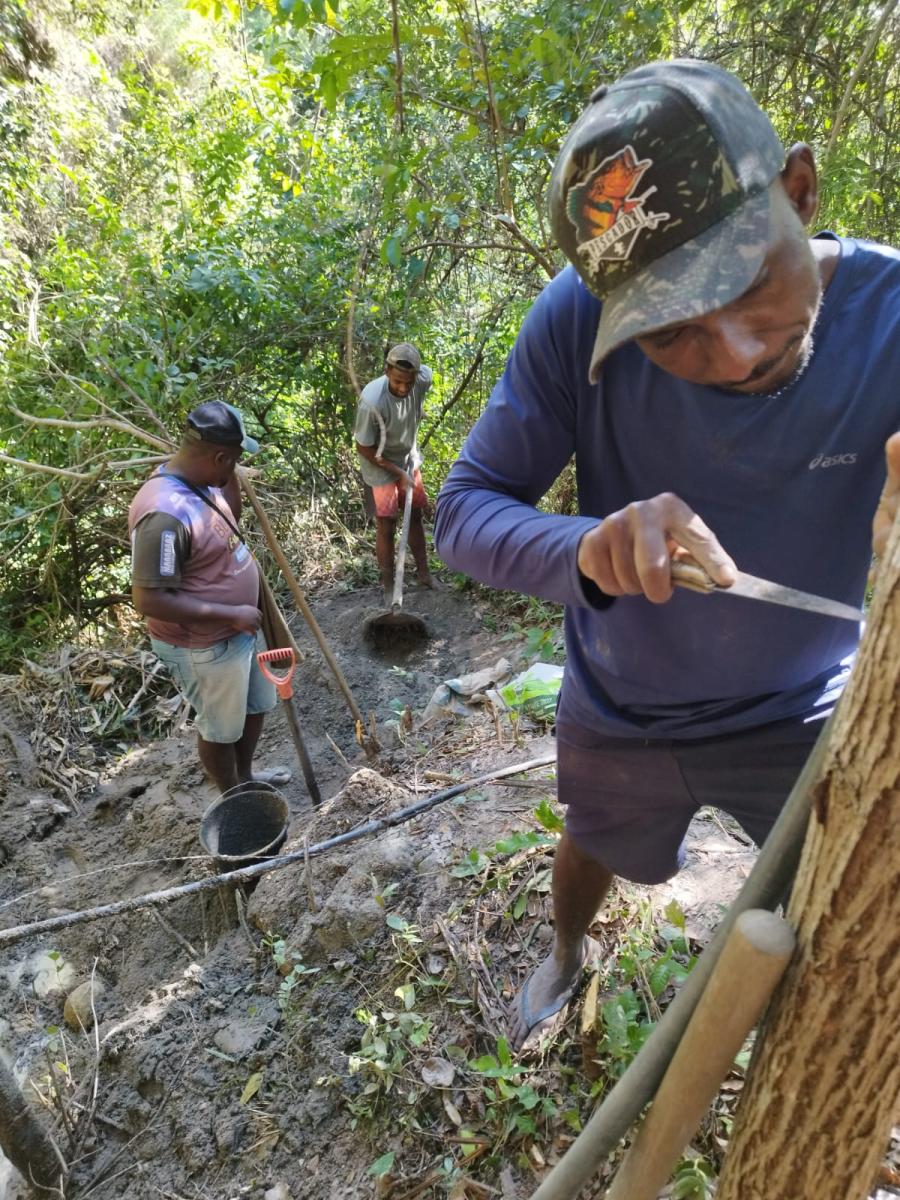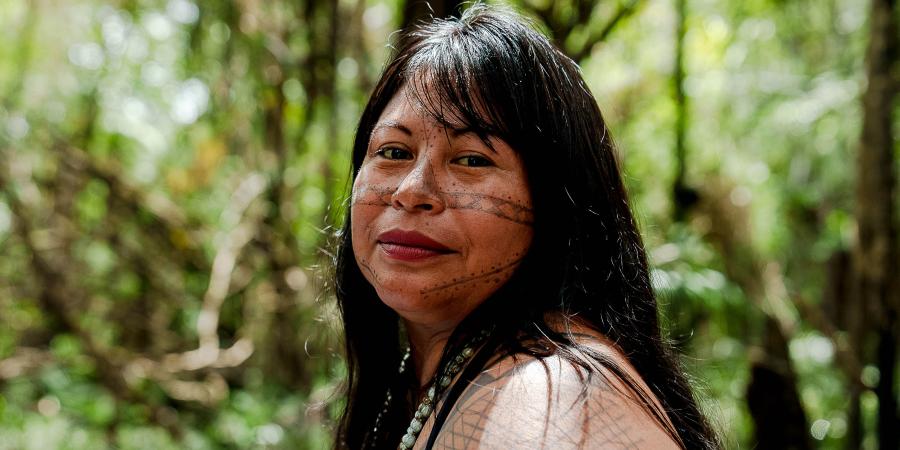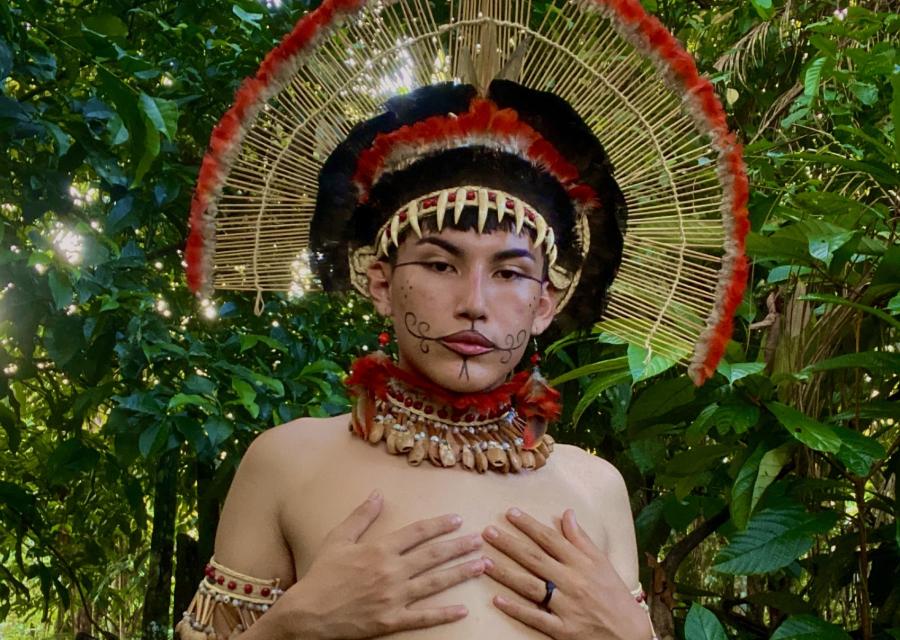This issue of CSQ documents the continuing violence that is being done to the Indians of Brazil. The government takes no action against the thousands of miners who are in Yanomamo territory, yet it forbids priests, anthropologists or any others who speak out for the Indians to remain in or even visit Yanomamo land. It does little about frontiersmen who kill Indians, yet it prosecutes two Kayapó Indians and an American anthropologist working among the Kayapó in the service of a Brazilian institution for the "crime" of telling world Bank officials in Washington about Kayapó objections to a dam that the government proposes to build on their lands with World Bank loans. Why is this happening and why are matters relating to the Indians, who make up less than one percent of Brazil's population, now treated by the authorities as issues of national security?
It was not always so. Indian affairs were handled earlier in this century by the SPI (Service for the Protection of Indians) founded by Candido Mariano Rondon, who became a Brazilian hero. Rondon advocated a policy of be friendly the Indians at the frontiers, helping them to become part of the nation. Thanks to Rondon, since 1911 Brazilian law has guaranteed to Indian peoples their lands and the right to maintain their own customs through the assistance and protection of SPI. But this benevolent paternalism was dramatically undermined in the 1960s, when Brazil began in earnest to open up its Amazonian frontier.
Indians and the Military Government
The military government that came to power in 1964 encouraged development at all costs; it was not squeamish about the rights of people, Indians or non-Indians, whom it considered to be "standing in the way of development." The overextended and underfunded SPI found itself unable to protect the Indians against the effects of the government's policy of unbridled frontier expansion. Some SPI officials were accused to complicity with the invaders of Indian lands, of selling out the Indians or even of aiding and abetting those who were killing Indians in order to claim the "unoccupied" areas. The world press began to carry stories of genocide in Brazil.
The government dealt with this by promising to punish those SPI officials found guilty of wrongdoing - a promise that it did not keep. Meanwhile it disbanded SPI and replaced it with FUNAI (the National Indian Foundation). But FUNAI is caught on the horns of the same dilemma that led to the demise of SPI. FUNAI exists in theory to help the Indians and to defend their interests. Yet FUNAI is a government agency and Brazilian government policy has, since the 1960s, emphasized a kind of development that has had terrible consequences for Indians, and also for the non-Indian poor, who comprise the majority of Brazil's population. FUNAI, like SPI before it, cannot protect the Indians from the consequences of Brazilian government policies.
On the contrary. FUNAI's motto from the start has been "Security and Development." The agency saw its task as being the rapid integration of the Indians into the national life. It was an agency of the Ministry of the Interior, and the Minister of the Interior in the 1970s made his own view of development clear when he said O boi e o grande bandeirante da decada ("The steer is the great explorer of this decade"). Cattle ranches were encouraged in areas in which Indians and others were making "unproductive" use of the land. Meanwhile the Indians would be gathered into villages under the tutelage of FUNAI where, under the notorious system known as the renda indígena ("Indian income"), they would be put to work. The income they produced would go to FUNAI, who would use it "on behalf of the Indians" - which, in fact, meant to pay FUNAI's own operating costs.
These policies aroused fierce opposition. Indians organized to defend themselves, aided by CIMI (the Indianist Missionary Council), the arm of the Brazilian Catholic Church that works on behalf of Indians. National organizations were formed to work for the Indian cause, assisted by international organizations such as Cultural Survival, which began to monitor Brazil's treatment of its Indians.
The government, through FUNAI, made tactical concessions but never abandoned its goal of integrating the Indians as rapidly as possible. It therefore proposed that the Indians should be "emancipated," an idea that has been central to Brazil's Indian policy for the last decade. The Minister of the Interior argue that emancipation would free Indians from the tutelage of FUNAI and hasten their absorption into the Brazilian melting pot. But the Indians pointed out that they were entitled under Brazilian law to keep their lands and their customs and that FUNAI was the agency that was supposed to help them to do this. Instead of abolishing FUNAI, they argued, the government should make FUNAI do its job.
But the government has persisted in its determination to abolish the very category of "Indian" (and thus the special protection theoretically enjoyed by Indians) in Brazil. Meanwhile it began to insist that mining should be permitted on Indian lands. A gold rush took thousands of prospectors to the state of Pará 10 years ago, and large reserves of other minerals were discovered in the Amazonian regions. Where these lay under Indian lands, FUNAI was supposed to issue permits for their extraction under strict FUNAI control. But FUNAI has never succeeded in controlling the invasion of Indian lands by prospectors, and is quite unable to police the activities of large and influential mining companies.
In the early 1980s the demarcation of Indian lands was made much more complex: it was no longer solely a matter for FUNAI. FUNAI had to start the process, but was then required to submit its results to an interministerial council, which often demanded fresh studies. Eventually, if the council approved, the demarcation decree was sent to the president of the republic for his signature. As a result, the demarcation of Indian lands, already scandalously in areas, was virtually paralyzed.
Indians and the Civilian Government
The return to civilian rule in 1985 has produced no major changes favorable to the Indians. A weak civilian regime finds itself beset with problems. Brazil's "economic miracle" of 20 years ago has turned into the economic disaster of today. One of the reasons why the military abandoned its control of the country was that it was presiding over an economic crisis and had run up the notorious Brazilian debt - a burden under which the country now staggers. Yet the present government has not taken effective measures to deal with the national crisis. Land reform is desperately needed in rural Brazil. President Sarney announced when he took office that this would be one of his urgent priorities, but he has shelved it in the face of powerful conservative opposition. During these years of crisis and drift the civilian administration has continued the Indian policy of its military predecessors.
Meanwhile, the Indian question again became a national issue during the deliberations of the body convened by the civilian government to draft a new constitution for Brazil. The constitutional convention naturally had to deal with the question of Indian rights. Pro-Indian advocates at the convention wanted brazil to be officially declared a multi-ethnic nation, in which Indian lands and Indian ways of life would be guaranteed and protected. They opposed FUNAI's policy of emancipation and that agency's attempts to define Indianness so that certain Indians (and eventually all Indians) could be declared no longer Indian and thus no longer enjoy any special status under the law. Opposed to these views were those who held that Indians should not be recognized permanently under the new constitution and that the document should for see their rapid integration (i.e., disappearance) into the Brazilian population.
In support of the latter position many conservative Brazilian newspapers, using data supplied by FUNAI itself, argued that Indians, who comprise a tiny fraction of the population of Brazil, have far too much land. A study of these allegations carried out by Brazilian anthropologists demonstrated, however, that they were based on misleading manipulations of gross statistics. Only 7.1 percent of the lands counted by FUNAI as "Indian lands" have actually been registered as such. FUNAI has not even initiated the process of demarcation for more than half of the lands it lists as "Indian lands." Much of the supposed Indian land has already been invaded and is neither used nor controlled by Indians.
Moreover, FUNAI and the newspapers compared the amount of land per person supposedly controlled by Indians to the national average, when it should have been compared to the rural average, since all Indians live in rural areas. When compared to the rural average, even the inflated figures for the Indians show them as controlling less land per head than is the rural norm. In any case, such figures are quite misleading, since land in Brazil is unequally distributed. In most rural areas, residents do not have sufficient land - a fact not reflected in gross figures of hectares divided by total population.
Yet these statistical slanders are mild compared to other accusations in the campaign against Indian rights. In 1987, just before the constitutional convention was due to vote on the articles dealing with Indians, the, Estado de Sao Paulo, the major newspaper in Brazil's major state, ran a series of front-page articles for a full week denouncing the supporters of the Indian cause for being engaged in what was headlined as "Conspiracy Against Brazil." The Estado accused CIMI (and thus the Brazilian Catholic Church) of taking instructions from a so-called "Christian Church World Council" that was said to be coordinating an international conspiracy to restrict Brazilian sovereignty, especially in the Amazon. This would benefit foreign mineral companies at the expense of Brazilian ones. CIMI and other pro-Indian organizations were accused of manipulating the Indian issue to advance an internationalist cause that was profoundly harmful to Brazilian interests. The articles were picked up by newspapers all over the country, so that the accusations were broadcast nationwide.
The Church responded immediately by initiated legal action against the newspaper, requesting (and obtaining) a Parliamentary Commission of Inquiry to investigate the accusations, and publishing its own response. The reply argued that the newspaper had misinterpreted the constitutional provision for Brazil to be a multi-ethnic society, as one of "dividing Brazil." It also showed that much of the "evidence" on which the Estado's sensational articles were based came from articles and reports that were partially and misleadingly quoted or were themselves suspect. For example, its documentation of the implausible link between CIMI and a nonexistent Christian Church World Council (presumably a clumsy attempt to implicate the World Council of Churches) was a forgery. The campaign appeared to have been inspired by Brazil's largest tin mining company, the Grupo Paranapanema, whose mining rights on Indian lands, granted by the last military president Joao Figueiredo, were being challenged by CIMI in the courts.
In spite of the Church's prompt response and of widespread skepticism about the Estado's charges, the campaign had its effect. It put the Indianists on the defensive and frightened away middle-of-the-road members of the constitutional convention who might have voted in favor of the Indian articles without giving them too much thought. The pro-Indian activists had to mount an all-our campaign to save what they could at the convention. In this they were aided by a continent of Indians, mostly Kayapó, who sat, painted and feathered, day in and day out, inside the parliament buildings, impressing the framers of the new constitution with their fortitude and persistence. In the end the article proclaiming Brazil a multi-ethnic society was voted down. Indian lands were not constitutionally protected against mining interests, though it was stipulated that they could only be mined under special circumstances with specific government authorization. But at least the rights of the Indians to their lands and their ways of life were written into the constitution and FUNAI's more objectionable policies of emancipation were excluded.
Conflict Escalates Throughout the Country
This partial victory for Indians in law has to be set against the violence being done to Indians in fact in present-day Brazil. Mining and timber interests and agribusiness's are encroaching on Indian lands and Indians are being killed in the process. Meanwhile FUNAI supplies arguments to those who claim that Indians "stand in the way of development" and continues to press for the integration of all Indians into Brazilian society as quickly as possible, FUNAI has only completed the legal procedures for demarcating and guaranteeing a small fraction of all the "Indian" lands it includes in its statistics; yet it has now announced that in the future it will only attempt to protect the lands of unacculturated Indians. Since FUNAI sets itself up as the judge of who is Indian and who is not, this measure will enable it to "emancipate" Indians administratively, although the procedure has not been authorized in law. Indians whom FUNAI decides are acculturated - and such a determination may be made if they so much as can speak Portuguese - lose their rights to land and may at best be assisted in colonías indigenous ("Indian settlements") where FUNAI will teach them as rapidly as possible how to give up being Indian.
The campaign that is being waged against the Indians and their supporters touches on very sensitive issues: on Brazilian sovereignty, Brazilian nationalism and the very definition of Brazilian nationality. The Estado de Sao Paulo portrayed pro-Indian advocates as conspiring against Brazil and against Brazilian mining companies and, hence, against the development of Brazil. FUNAI, the official protector of the Indians, suggests that Indians have too much land, that they should not be allowed to impede development and that their desire to retain their own cultures is somehow un-Brazilian. It is implied overall that the nation has to choose between Indians and their rights on the one hand and Brazil's destiny and development on the other.
This is also the view of the military, which remains extremely influential in Brazil. It is pressure from the armed forces that has turned Indian questions into matters of national security. The Brazilian military views with disquiet the growing international attention that is being paid to the Amazon region, and is not amused by the occasional suggestions in other countries that the Amazon should be internationalized. Officials are determined instead to link the region more effectively to the rest of Brazil, to defend its frontiers, to populate it and to use its resources for the development of the nation. This is the background to the Calha Norte Plan, calling for immense expenditure on roads and settlements along Brazil's Amazonian frontiers.
The armed forces continues to insist on is special mission to protect the order and stability of the nation and to deal with those who would subvert that stability. Now that official government policy favors development through large agribusinesses and mining companies in rural areas, the military throws its weight against advocates of land reform. Those parts of the country in which the rural poor, usually supported by the Catholic Church, are aroused over the land issue are therefore declared "areas of national security" and placed under special restriction.
Finally, the military is acutely conscious of the explosive combination of political unrest and drug trafficking that has destabilized neighboring countries such as Bolivia, Peru and Colombia; it is determined to prevent the Brazilian Amazon from being sucked into these processes.
These sensitive issues directly affect the Indians. Most Brazilian Indians live in the Amazonian regions; many of them are near the frontiers or occupy lands coveted by big businesses. They are said to impede access to the nation's mineral resources and to stand in the way of development. Worst of all, their plight has been compared to that of the rural poor and has received both national and international attention, which makes them suspect as potential "subversives." That is why Indian issues - and particularly questions relating to Indian land rights - now have to be referred to the National Security Council, the president's highest group of advisers, in which the influence of the military is very strong.
The Indians have become scapegoats at a time of national crisis in Brazil. Countless specialists have pointed out that they are not involved in drug trafficking, that they do not "stand in the way of development" and that their lands and cultures could be guaranteed without undermining Brazil's economy or its society. The causes of Brazil's social and economic problems lie elsewhere. These problems will not be solved by seizing Indian lands and destroying Indian cultures. Such measures are being taken because they suit powerful interests, and they are being defended with the rhetoric of national development because it is through that the Indians and their supporters are too weak to resist.
But the Indians continue to fight for their rights, against the odds. They have a lot of support among their fellow citizens in Brazil, as the votes in the constitutional convention showed. They need the understanding and the help of informed people throughout the world to continue their struggle.
Article copyright Cultural Survival, Inc.



